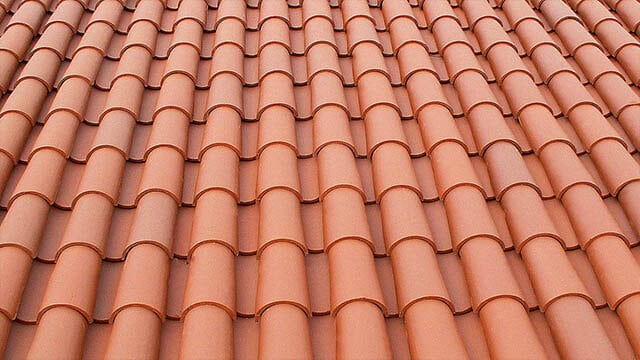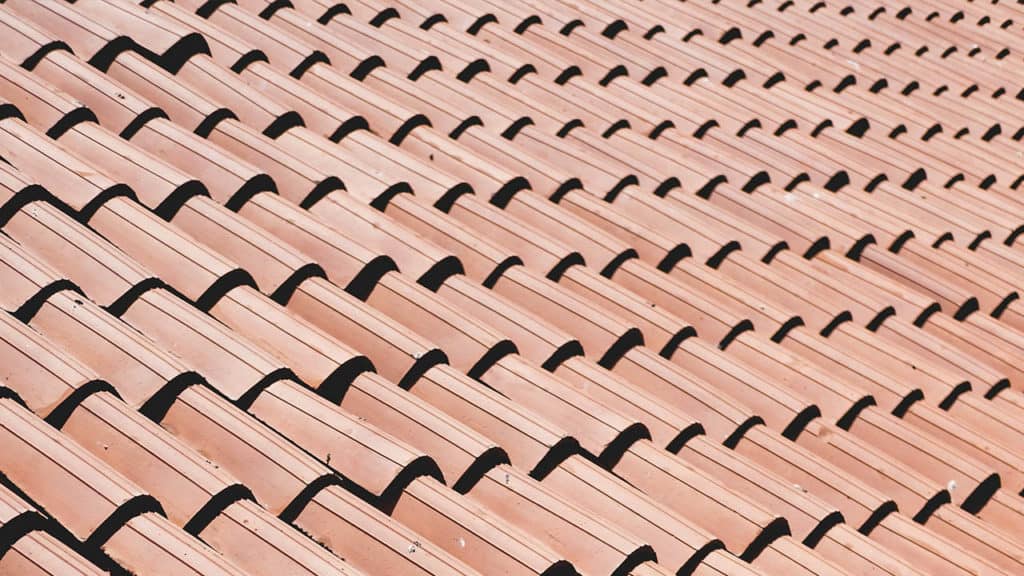Tiles are one of the most popular residential roofing materials in San Antonio and the entire USA. A tile roofing system not only improves your home’s curb appeal but also promises the most expansive options in terms of style. Besides, they are guaranteed to last a very long time when installed by a professional roofer and properly maintained.

There are various tile profiles to choose from, with concrete and clay tiles creating the foundation of modern tiling systems. They are made from molded clay and a mixture of cement and sand.
Popular as they are, how much do you know about clay and concrete tiles? Today, we will discuss the difference between these two options. We hope you will make a good decision in the end.
Clay Roof Tiles
As mentioned earlier, clay tile roofs are made from natural roofing materials. Clay can be found everywhere. It’s then molded into tile shapes through a form before being baked until they are hard.
There are various sub-categories in clay roofing tiles, too, depending on the type of soil used. Premium tiles are exposed to fire for extended periods of time under extremely high temperatures, making them stronger. They can last for more than 100 years.
You get a range of colors in clay tiles, including white, yellow, orange, reddish, and brown. But the most popular roofing title for clay tile roofs is terra cotta. This naturally occurring material can be recreated to resemble any other style to meet the homeowner’s needs.
How Are Clay Tiles Made?
Clay tiles are made from natural material; hence, they are eco-friendly and easier to recycle compared to many other roofing materials. High-quality soil is picked and baked into shape to create the desired tile style. And then, it’s exposed to high temperatures for a long time to strengthen them and also seal the color, so it never peels or fades off.

Advantages of Clay Tiles
Clay tiles promise several advantages. Here are some of them:
Excellent insulators
Clay tiles absorb heat but don’t conduct it. This means much heat is retained to help you during freezing temperatures in your home. Also, you spend more on AC power needed to warm your house.
Extremely durable
Both clay and concrete tiles are extremely durable. When properly installed, they can last for more than 100 years.
They don’t require too much maintenance
A clay tile roof costs a lot on installation compared to other materials. But you will get long-term value from its low maintenance requirements. It will be long before you start thinking about changing anything when properly installed.
Eco-friendly
Clay tiles are 100% recyclable. They can be crushed and turned into other uses. So, an old clay roof can still find more use in another place, like in building roads.
Variety and aesthetic
Clay tiles offer more aesthetic selection than many other roofing materials. You can construct your home in a wide range of shapes and colors, including using stone-coated steel tiles to give your home a stone-like appearance.
Weather-resistant
Clay tiles perform so well in different weather conditions. They are class A fire-rated, making them extremely fire-resistant. They also withstand freezing temperatures much better than many other roofing materials. In short, clay tiles protect your home from bad weather.
Disadvantages of Clay Tiles
Clay tiles improve your roof’s structure significantly and are a very impressive choice. However, they come with several limitations, too, including the following:
Hard to install
Installing high-end clay tiles requires top-notch skills and experience. And that is why there are not very many installers. For instance, they should only be installed on a roof that is 4/12 pitch.
They are heavy
Proper installation of clay tiles requires additional support on the roof framing. Installers should put the extra weight in mind. Otherwise, they will end up collapsing.
More expensive to install
Due to the complex nature and the risk of installation, clay tiles cost more per square foot than other materials. Also, proper maintenance is needed if you want them to last longer, which could lead to extra costs.
Susceptible to damage
Potential water absorption is one of the major risks of installing tile roofs. And that is why they need professionals with proper experience. The last thing you want is spending on a re-roofing project because someone did a shady job.
Brittle
Clay tiles are very brittle and will easily break when walked over, making maintenance quite challenging, even when you want to clean a part of the roof. If the tiles are damaged or broken, you will need a roofing expert to check and replace them.
Heat absorbent
Heat absorption is useful in colder climates. But things can get a bit tough for those who live in warmer climates. It becomes even harder with old tiles.

Concrete Tiles
Concrete roof tiles are crafted from regular concrete. Unlike clay roof tiles, which come from a single material, concrete tiles are a mixture of sand, cement, aggregate, and water. During drying, a chemical reaction called curing occurs between the cement and the water.
Concrete is a very strong and versatile roofing material. It naturally occurs in gray, but mixing it with paint creates a different look.
You will get these tiles in three main types:
- Flat tiles – they have not curved and resemble roofing shingles
- Low profile. These are tiles with a small curve. Sometimes it’s hard to notice the curve unless you are very close.
- High profile. They have large curves, mimicking clay tiles.
You can simulate your concrete roof to look like it has a different roofing material by altering the mold appearance. For instance, you can design it to resemble a clay tile roof using a certain color on high-profile concrete tiles.
Advantages of Clay Roofs
A general advantage both concrete and clay tiles share is their durability. Aside from that, here are other pros you will get from a concrete tile roof:
Versatility
Concrete tiles are more versatile than clay. You can easily tell a clay tile roof from a distance since many follow the traditional design. Concrete roofing tiles, on the other hand, can be molded to resemble wood shake, asphalt, or slate shingles.
Durable
Concrete tile roofing can last for more than 50 years. Your roof structure will most like remain intact even for heavy foot traffic. They are not as brittle as clay tiles.
Better handling of strong winds
Concrete is strong, heavy tiles that can withstand winds up to 200mph. This is one of their biggest advantages over clay tails, making them a choice for areas that experience extreme weather conditions.
Tested for impact resistance
Concrete tiles offer the best structural reinforcement since they are tested for impact resistance. They handle falling objects, heavy snow loads, winds, and water much better than clay tiles.
Great color choice
Concrete tile roofs can be painted in any color. So, whatever your choice, you can make them look as you want.
Energy efficiency
With a concrete tile roof, you can enjoy reduced utility costs. They absorb heat but don’t conduct it. That means your home will remain warm through the colder times of the day.
Disadvantages of Concrete Tiles
Both clay and concrete roof systems share similar pros. That also means they have identical cons. Here are specific disadvantages to expect when using concrete tiles:
Extremely heavy
Concrete tiles are the heaviest roofing materials on the market. On average, concrete tiles weigh 500 – 720 lbs per square foot. Hence, the roof structure must be able to support such weight.
They can fade
Even though they come in various color choices, the surface paint may fade with time. When repairs are done on the old tiles, it becomes hard to match colors.
Concrete tiles absorb water
The possibility of absorbing water is much higher in concrete tiles. However, this should be fine if qualified installers properly install them.
Hard to install
Not everyone can install cement tiles. Apart from their weight, they require experience and specialization to achieve proper installation. That also means they cost more per square foot. It might take time to find a qualified installer.

Clay vs. Concrete Roof Tiles – Which One is the Best
According to experts at Bison Roofing, there is no significant difference between clay and concrete tiles in terms of performance. However, they still show variations in style, installation cost, repairs, and composition. The most important thing is to hire a professional contractor who understands tile roofing systems appropriately.
Style and Color Variety
Clay are traditional tiles that have been around for centuries. Concrete tiles were developed much later, although they tend to share a similar history. Both clay and concrete tiles are more popular in the US than anywhere else in the world.
Concrete tiles offer more style and color variety for less cost. They can be designed to mimic different shapes, textures, or sizes and colored to resemble clay tiles. That means you have a lot more to choose from.
Clay tiles should be great if you need something more classic and historic. Even if concrete tiles are crafted to look like clay ones, you can still easily discern them.
And for those who want modernity and paint variety, consider concrete tiles. Besides, they are excellent if you want to save a dollar.
Installation and Cost
The main difference between clay and concrete tiles is weight. Concrete ones tend to weigh more when dry and even heavier when wet. This makes it hard to install in awkward angles.
Generally, carrying tiles on the roof is a heavy task. You can easily get too many broken tiles before you finish the project. Cement or concrete tiles make it even harder.
Get ready for the extra labor and, consequently, more cost per square. Concrete tiles cost about $4.50 to $10.50 per square foot, while clay tiles cost $6.00 to $14.50. The exact price depends on the quality of the material, although clay tiles remain slightly more expensive.
The total cost of installation also varies. A professional roofing contractor will charge an average of $10.000 and $20.00 per square foot to install concrete tiles. On the other hand, it will cost you between $12.50 and $25.25 per sq for the clay tiles. The exact cost will depend on the specific material and the roof slope.
Repairs
It’s important to start planning for repairs as soon as you install a new roof on your home. Repairs are necessary, whether it’s concrete, soil, or stone tiles. Luckily, they are fairly easy.
Repairing traditional tiles generally includes checking for breakages and replacing them. Clay tiles are, however, more brittle than concrete ones, which could increase the difficulty. Concrete tiles, on the other hand, are much heavier, which is why you should only let a professional roofing contractor work on them.
Composition
Clay tiles are made by baking molded clay mined from the ground. A few other materials, including minerals and chemicals, can be added for definite shapes and strengths. It is then exposed to high temperatures during certain periods.
Concrete tiles are a mixture of cement and aggregate with water. Color and other materials could be added to the mixture for strength and durability. Manufacturers can then pick a specific tile shape to meet the owner’s needs before heating it to dry.
Clay vs. Concrete Roof Tiles – Summary
Traditional tiles are made from clay or concrete; both have been popular roofing options for centuries. They are preferred over other materials due to their durability, watertight, energy efficiency, fire resistance, low maintenance, and general aesthetics.
They are an excellent choice for your San Antonio home. Concrete is cheaper than clay, but it’s heavier. Clay tiles have been around for ages because they work and they last much longer.
Whatever your choice, you need a highly experienced roofing expert. Call Bison Roofing, and you can put all your worries to rest. With more than 25 years of experience, your roofing project is in the best hands.
